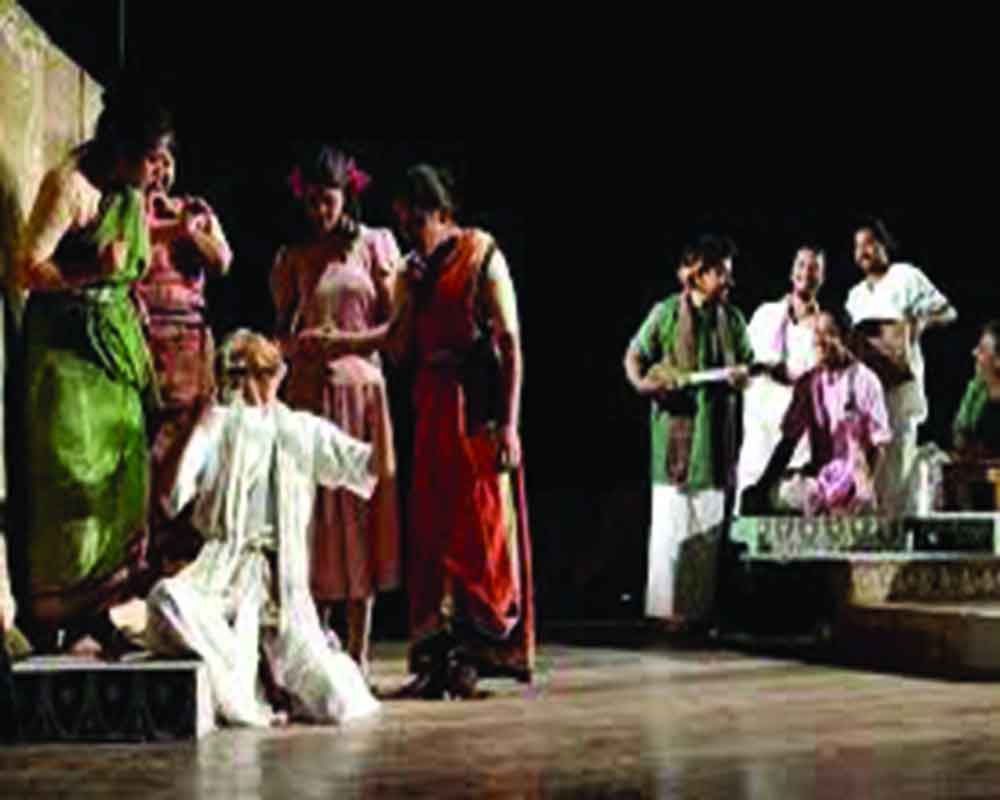A major reason for decline of Ipta was the CPI’s tight control over its cultural units which were forced to do propaganda
Ipta entered the world of cinema. By 1946, Ipta members had done two films. Neecha nagar, released on September 29, 1946, was directed by Chetan Anand. The other was Dharti ke lal; released on August 30, 1946, it was directed by K.A. Abbas.
Music of both the films was scored by Pandit Ravi Shankar. Prominent Ipta members Shambhu Mitra, Tripti Mitra, Zohra Sehgal, Krishan Chander, Kamini Kaushal, etc., were all part of the films. While Dharti ke lal, based on the Bengal famine, got some positive reviews,
Neecha nagar got a raw deal. The Times of India said, “The story of Neecha nagar is the corniest chestnut of the Indian screen: Rich vs Poor, Capital vs Labour….” But the film, based on a story of Maxim Gorky, won a Grand Prix award at the Cannes International Film Festival in 1946. Another film backed by Ipta was V. Shantaram’s Doctor Kotnis ki amar kahani.
Ipta began theatre in Bombay, Calcutta, and other cities, drawing huge crowds. One of the earliest Ipta productions was based on Ismat Chugtai’s story. People realised that these productions were redefining the language of the Indian stage. It was a cosmopolitan, cultural revolution, something no other political party had thought before in India. In that sense, P.C. Joshi’s initiative was indeed a watershed in Indian politics.
From the beginning Ipta’s theatre was very distinctive; it was sophistically crafted. With exceptional stage designs, light and of course content, its plays captured people’s hearts. Ipta theatre was a confluence of various forms of Indian stage performances, blending the styles of Marathi tamasha, Bengali Jatra and Assamese jhumur in a single format. In Punjab it took the theme from folklore.
The play Nabanna, a Bengali production based on the Bengal famine written by Bijon Bhattacharya, rocked Bengal and Assam. It was first staged on October 24, 1943, in Calcutta. In the next few years, more than 40,000 farmers and mill workers watched it. No Ipta production could beat the popularity of Nabanna. The Marathi play Desha sathi, Telugu play Prarambham, and Urdu play Yeh kiska khoon hai were also very popular among people.
The golden period of Ipta lasted only till February 1948, when at the CPI’s Calcutta Congress, B.T. Ranadive captured power by sidelining P.C. Joshi.
Randive not only discarded Joshi’s reformist line but reduced Ipta activities as much as he can. He gave a call for an armed revolution against the Nehru government. The party was immediately banned in West Bengal and Andhra. It was the time when Ipta started disintegrating.
As the party was banned, there was suppression of its cultural front. The party too ignored its creative aspect. According to Basu Acharya, a Marxist scholar and researcher, one of the major reasons was the party’s tight control over its cultural units; these were forced to do propaganda only as per the party line. Such was the control over the Ipta that people like Ritwik Ghatak and Salil Chowdhury were asked to make music and films only in tune with the party line. As a result, talented people like Sachin Dev Burman, Ravi Shankar, Shambhu Mitra, and Salil Chowdhury started moving to the world of commercial cinema, dance, music and theatre.
Acharya thinks that Randive was wrong to call a revolution so early, as cultural surge emergence had just started; it was giving the CPI a huge mass support.
However, even after coming out of Ipta, its former members did not discard the dream of a classless society. They carried the spirit of Ipta without its affiliation.
Shambhu Mitra formed a Bengali group theatre group named Bahuroopi, while Raj Kapoor and Bimal Roy made films like Awara and Do bigha zamin, respectively. In Raj Kapoor’s movie, the pangs of the urban poor were shown; in Bimal Roy’s movie, the mass migration to cities and then reverse migration were very nicely captured. Needless to say, both the films got a huge reception in Moscow where they were treated as Ipta works.
Though Ipta was active till the CPI suffered a split in 1964, it was not even its shadow of the 1940s. Meanwhile, the cultural spectrum of India saw a sea change, as the entertainment of mass popular cinema, film music and commercial theatre gradually took over. After 1964, except Balraj Sahani, Kaifi Azmi, Habib Tanveer, Shabana Azmi, Javed Akhtar, etc., only a few popular faces involved themselves actively with Ipta. In Bengal, the new party CPI(M), born out of the split, got the Ipta name whereas the CPI renamed it as IPCA. However, at the all-India level, the CPI still owns the name Ipta. In 2017, Ipta celebrated its 75 years in Patna with a big festival with theatre, song and street plays.
The Bombay unit of Ipta is still very active. They regularly perform theatre and street plays. In other states IPTA is now more on paper than stage.
The emergence of Ipta in the mid-1940s inspired people to fight against famine, riot, war, partition, brutality with which the naval mutiny was suppressed, the Tebhaga movement, etc. It gave Indian culture a galaxy of talented artists. India’s cultural history will be incomplete without Ipta’s contributions.
(The view expressed are personal.)


























